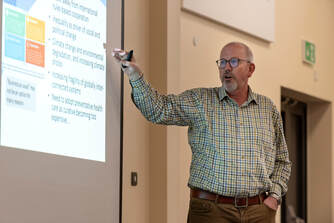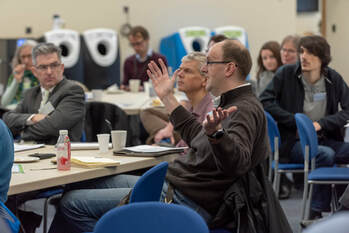 STFC HARWELL CAMPUS, 17-18TH JANUARY 2019 The 2019 STFC Food Network+ Showcase started with an insightful introduction to 21st Century Challenges from Professor Grahame Blair (STFC Executive Director, Programmes Directorate), setting the scene for the contribution that the SFN and STFC as a whole have made in this research area. This lead nicely into a rousing call to arms delivered by Professor of Population Dynamics Tim Benton (University of Leeds): “Our current food system is failing and inefficient, with the associated health and environmental costs being 5 to 10 times greater than the agricultural value of our food”. Describing the sheer complexity of the problem, and the daunting challenge of adapting to climate change, such an opening talk could have cast a pessimistic gloom across the meeting. But Tim wrapped up with an inspiring vision for how a positive future food system could look, including enthusiasm for the important role technology can play. Throughout the two days it was clear that the members of the STFC Food Network+ are using such challenges as inspiration for finding solutions through creative collaborations, new ways of using technology and rethinking entire supply chains. We had come together to hear about the results achieved so far by the 20 projects funded in the 2018 STFC Food Network+ Collaborative Scoping Call. Although these covered everything from avocados to arsenic poisoning, there were noticeable themes uniting them together. One of these was the potential for Big Data and Internet of Things technologies to revolutionise the food system. We heard how the possibilities for these technologies are as varied as they are exciting, and applicable at both ends of food supply chains, for instance in determining the exact amount of fertiliser to apply or redistributing surplus food products. But as Guy Poppy (Chief Scientific Advisor to the Food Standards Agency, FSA) pointed out: “Data has no value unless it can be turned into wisdom”. Without identifying the metrics that are actually relevant to the user, one is simply left with a meaningless ocean of information. Many STFC Food Network+ projects are addressing this, ultimately helping Big Data technologies to make the leap from theoretical possibilities to effective solutions that, as one researcher put it, ‘bring benefits that result in cold, hard cash for farmers’ and other players in the food sector. Working together with all the stakeholders in the agri-food sector was another common thread between these projects. Clearly, the most effective solutions can’t be developed in isolation from those who need them. Wantao Yu (University of Roehampton), for instance, is leading focus groups in Henan Province, China, to work out how Big Data technologies could best be applied to connect rural small holder farmers to agri-businesses. Similarly, Sonal Choudhary (University of Sheffield) convened multi-stakeholder workshops in India to identify the critical problems that cause up to 40% of fresh fruit and vegetables to be lost as food waste in this region. “We identified four key areas that could have immediate impact on farmer’s incomes if we targeted them” she said. “We found that connectivity, not productivity, is the main problem”. For those who worry about Big Data technologies usurping jobs and livelihoods, the ultimate aim for all these projects was rather to empower farmers and other actors in food supply chains to make better decisions. Examples included using weather-pattern data to decide which crops to plant (the FACYNation Project, Seb Oliver, University of Sussex); helping farmers to non-invasively detect pregnancy in cows (Niamh Forde, University of Leeds), and identifying potential avenues to redistribute surplus food (the APROV project, Luciano Batista, Aston Business School). Besides digital technologies, we learnt how an impressive array of other sophisticated techniques are addressing specific industrial problems. Once again, these involved close collaboration with end users to deliver outcomes fit for purpose. After all, a technique may provide accurate, comprehensive information but it won’t be taken up within the industry if it needs hours to run, technical training and expensive equipment. We heard, for instance, how X-ray imaging can detect arsenic levels in rice grains (Manoj Menon, University of Sheffield); the potential of Raman scattering to single out adulterated fruit juices (Paul Richardson, The University of Manchester) and the use of volatile organic compounds to non-invasively ‘sniff out’ poor quality avocados and the freshness of bagged salads ( Marcin Glowacz, Natural Resources Institute, University of Greenwich and Hilary Rogers, Cardiff University). Excitingly, some projects are already at the stage of developing portable prototypes ready for use.  In between the presentations, there was a constant hum of discussion, catching up with friends, making new acquaintances and discussing new ideas and proposals to follow up. This, alongside the impressive portfolio of projects, underscores how valuable the STFC Food Network+ is as a forum for generating novel solutions and connecting up the expertise, funding and world-class facilities to make them happen. Representatives from various organisations, including DEFRA, FSA, BBSRC, NERC, STFC and InnovateUK , were on hand throughout to present their current opportunities for funding, making the search for ‘that perfect grant’ considerably easier. We also had the chance to visit some of the impressive STFC facilities on the Harwell Campus, including the Diamond Synchrotron (capable of accelerating electrons to near-light speeds) and the RAL Space Centre. Watching a space satellite being tested in near-space conditions was a fitting reminder of just what science can achieve when we work together and reach for the stars. Rethinking the food system is perhaps just as great a challenge as launching into space… but the creativity and innovation found in the STFC Food Network+ is a real cause for optimism. You can now access all of the presentations from the event here (With thanks to Caroline Wood, University of Sheffield author of this blog post)
0 Comments
|
AuthorJune 2024 - Archives
June 2024
Categories |
- Home
- Webinars and Events
- About the SFN+
- News
- Blog
- Expert Working Groups
- Funding
-
Publications
- Bioeconomy positioning paper
- SFN+ 5th Annual Conference
- OMM Policy Report
- ‘Multi-Stakeholder International One Day Workshop on Organic Agri-Food Value Chains for Net Zero’ Report
- SFN 2050 UK Net Zero Food report
- Sustainable Cold Food Chain Booklet
- Food Sensing Technologies for Safe and Nutritious Food
- Sustainable urban and vertical farming
- Projects
- Join/Contact Us

 RSS Feed
RSS Feed


